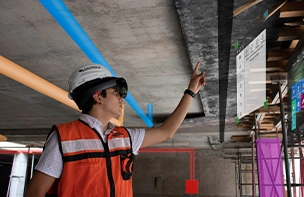
Mixed Reality represents a technological branch that combines aspects of Augmented Reality and Virtual Reality with the tangible environment, resulting in an immersive experience enhanced by the integration of additional resources. In this convergence, devices used in Mixed Reality typically take the form of transparent optical lenses that project virtual content onto binocular lenses. This setup is complemented by embedded computer vision tracking sensors, providing the illusion of blending digital content with the real world, thereby expanding sensory realism.
Through the use of this technological architecture, Mixed Reality (MR) solutions achieve a unique immersive perception by combining virtual elements and the real context. By harnessing advanced vision tracking sensors, these solutions achieve a remarkable perceptual synthesis, creating an experience that is perceived with increased realism. Ultimately, Mixed Reality not only expands the boundaries of immersion but also introduces new possibilities for interaction between the real and the virtual in various fields, including the construction industry.
Mixed Reality allows architects and designers to visualize and refine their creations in an immersive way, fine-tuning details in a realistic context.
Mixed Reality is used for simulating construction processes, aiding in the planning and optimization of complex projects.
Mixed Reality is used in presenting proposals to clients and stakeholders, showing how the final project will look in the real context.
Infrastructure projects, such as roads and bridges, benefit from Mixed Reality for assessing feasibility and interaction with the environment.
Training in safety and construction techniques is enriched by Mixed Reality, allowing workers to practice in simulated environments.
Mixed Reality enhances team coordination and decision-making by visualizing real-time relevant information at the workplace.
Mixed Reality allows visualizing projects in a real-world environment, facilitating detailed planning and early identification of potential issues.
Construction teams, architects, and engineers can interact and collaborate in real-time on virtual models in the real context.
The ability to overlay virtual elements in a physical environment helps fine-tune and optimize designs before construction.
The real-time simulation of construction processes enables more precise and efficient execution on the site.
Mixed Reality provides realistic and safe training opportunities for workers, improving their performance and safety.
Real-world context visualization aids in making more informed decisions regarding design, logistics, and project management.
Mixed reality has proven to be a valuable tool in the construction industry by enabling greater collaboration among teams, better visualization of designs, and early detection of errors and potential issues. Additionally, it has improved efficiency and safety in the workplace by allowing for better training and the reduction of costly errors. As technology costs decrease and become more accessible, mixed reality is expected to play an even larger role in the construction industry and help enhance the quality of projects worldwide.


Mixed Reality represents a technological branch that combines aspects of Augmented Reality and Virtual Reality with the tangible environment, resulting in an immersive experience enhanced by the integration of additional resources. In this convergence, devices used in Mixed Reality typically take the form of transparent optical lenses that project virtual content onto binocular lenses. This setup is complemented by embedded computer vision tracking sensors, providing the illusion of blending digital content with the real world, thereby expanding sensory realism.

Through the use of this technological architecture, Mixed Reality (MR) solutions achieve a unique immersive perception by combining virtual elements and the real context. By harnessing advanced vision tracking sensors, these solutions achieve a remarkable perceptual synthesis, creating an experience that is perceived with increased realism. Ultimately, Mixed Reality not only expands the boundaries of immersion but also introduces new possibilities for interaction between the real and the virtual in various fields, including the construction industry.
Mixed Reality allows architects and designers to visualize and refine their creations in an immersive way, fine-tuning details in a realistic context.
Mixed Reality is used for simulating construction processes, aiding in the planning and optimization of complex projects.
Mixed Reality is used in presenting proposals to clients and stakeholders, showing how the final project will look in the real context.
Infrastructure projects, such as roads and bridges, benefit from Mixed Reality for assessing feasibility and interaction with the environment.
Training in safety and construction techniques is enriched by Mixed Reality, allowing workers to practice in simulated environments.
Mixed Reality enhances team coordination and decision-making by visualizing real-time relevant information at the workplace.

Mixed Reality allows visualizing projects in a real-world environment, facilitating detailed planning and early identification of potential issues.
Construction teams, architects, and engineers can interact and collaborate in real-time on virtual models in the real context.
The ability to overlay virtual elements in a physical environment helps fine-tune and optimize designs before construction.
The real-time simulation of construction processes enables more precise and efficient execution on the site.
Mixed Reality provides realistic and safe training opportunities for workers, improving their performance and safety.
Real-world context visualization aids in making more informed decisions regarding design, logistics, and project management.
Mixed reality has proven to be a valuable tool in the construction industry by enabling greater collaboration among teams, better visualization of designs, and early detection of errors and potential issues. Additionally, it has improved efficiency and safety in the workplace by allowing for better training and the reduction of costly errors. As technology costs decrease and become more accessible, mixed reality is expected to play an even larger role in the construction industry and help enhance the quality of projects worldwide.



